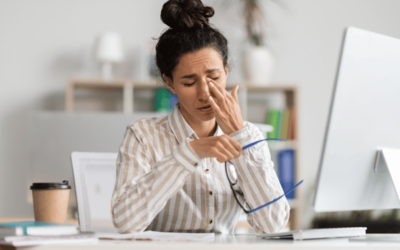You know that gritty, sandy feeling you get sometimes when you blink? Or how about when your eyes water but nothing seems to come out? And don’t even get us started on how red and irritated they can feel by the end of the day. If you experience any of these symptoms, you may be suffering from dry eye disease.
What is Dry Eye Disease?
Dry eye disease is a common condition that occurs when the eyes do not produce enough tears, or the tears evaporate too quickly. This can lead to a feeling of discomfort as well as visual problems. Although it can happen to anyone, dry eye is most common in women over the age of 50.
What causes dry eye?
There are many possible causes of dry eye, including the following:
- dry climate and/or windy conditions
- staring at computer screens or other digital devices for long periods of time (computer vision syndrome)
- driving for long distances
- smoking tobacco products
- certain medications such as antihistamines, antidepressants, blood pressure medications (beta blockers),
- hormones (oral contraceptives or hormone replacement therapy during menopause)
- eyelid problems such as blepharitis (chronic inflammation of the eyelid) or meibomian gland dysfunction (blockage of oil glands along the edge of the eyelid).
- In some cases, dry eye disease can be a sign of another underlying health condition such as autoimmune disease, diabetes, vitamin A deficiency, or thyroid problems.
There are several different treatments available for dry eye, but before we get into that, let’s take a closer look at the symptoms.
Symptoms of Dry Eye Disease
The most common symptom of dry eye is a burning sensation. This is usually accompanied by itching, redness, and a sandy or gritty feeling as if there is something in your eye.
Other symptoms include excessive tearing (although this may seem counterintuitive, it’s your eyes’ way of compensating for the lack of tears), difficulty wearing contact lenses, and temporarily blurred vision.
If you experience any of these symptoms, it’s important to see an eye doctor so they can properly diagnose and treat the condition. In some cases, dry eye disease can be a sign of another underlying health condition such as autoimmune disease, diabetes, vitamin A deficiency, or thyroid problems.
How is dry eye diagnosed?
A comprehensive dilated eye exam is necessary to diagnose dry eye and rule out other potential problems.
During this exam, your doctor at Louisiana Eye Care will ask you questions about your symptoms and medical history. Your doctor will also conduct several tests including measurement of tear production; testing corneal sensitivity; examination of the eyelids; assessment of meibomian gland function; evaluation of blinking quality; and examination of the ocular surface with a microscope.
Treatment for Dry Eye Disease
The good news is that there are several different treatments available for dry eye, depending on the severity of the condition. If you think you may be suffering from dry eye disease, the first step is to see an eye doctor so they can properly diagnose and treat the condition. With the right treatment plan, you can say goodbye to those painful, irritating symptoms and get back to enjoying your life!



